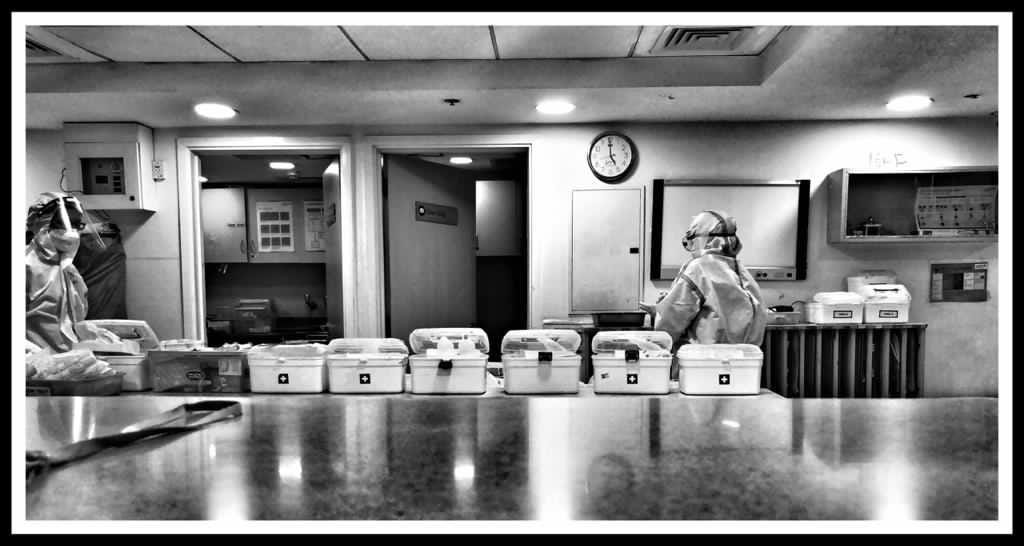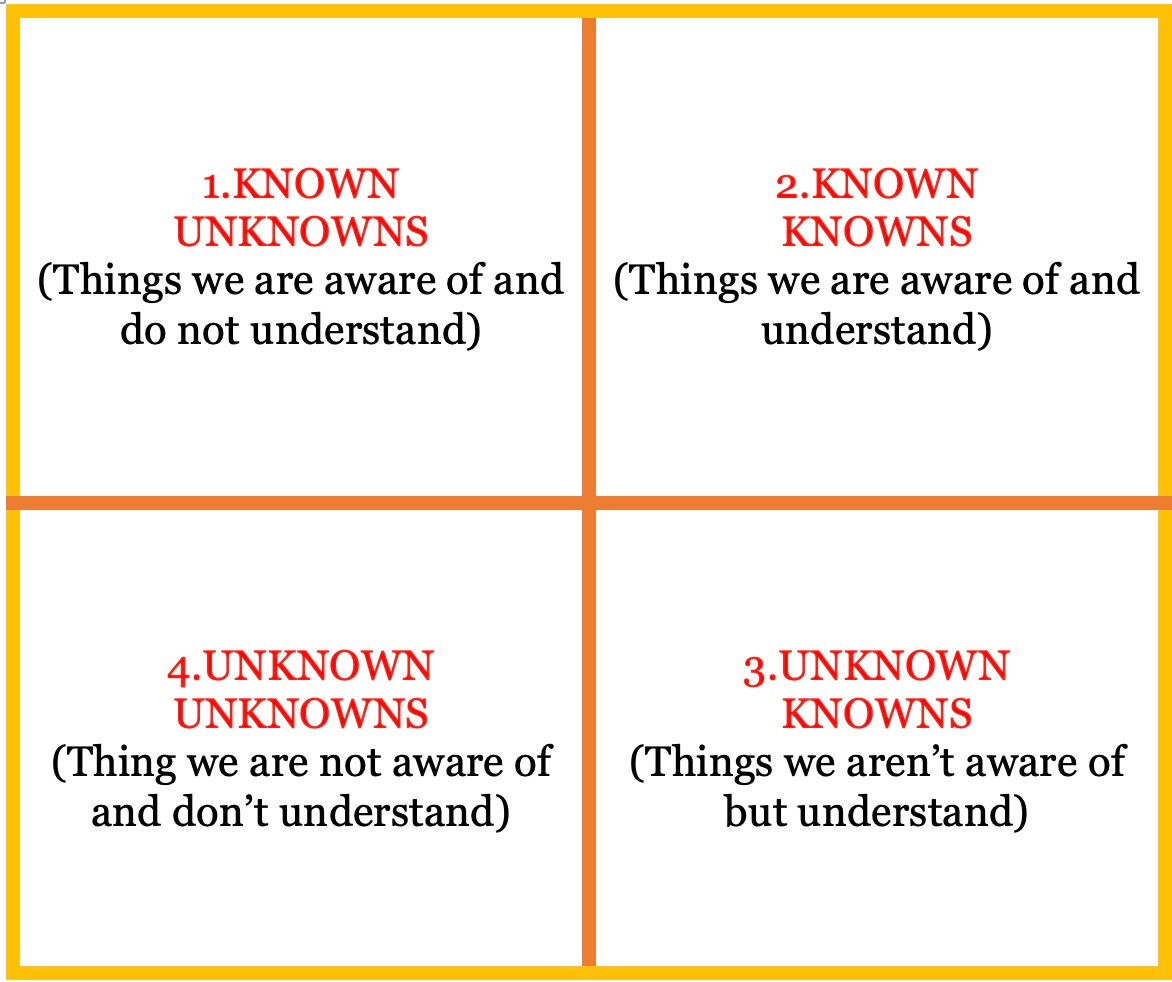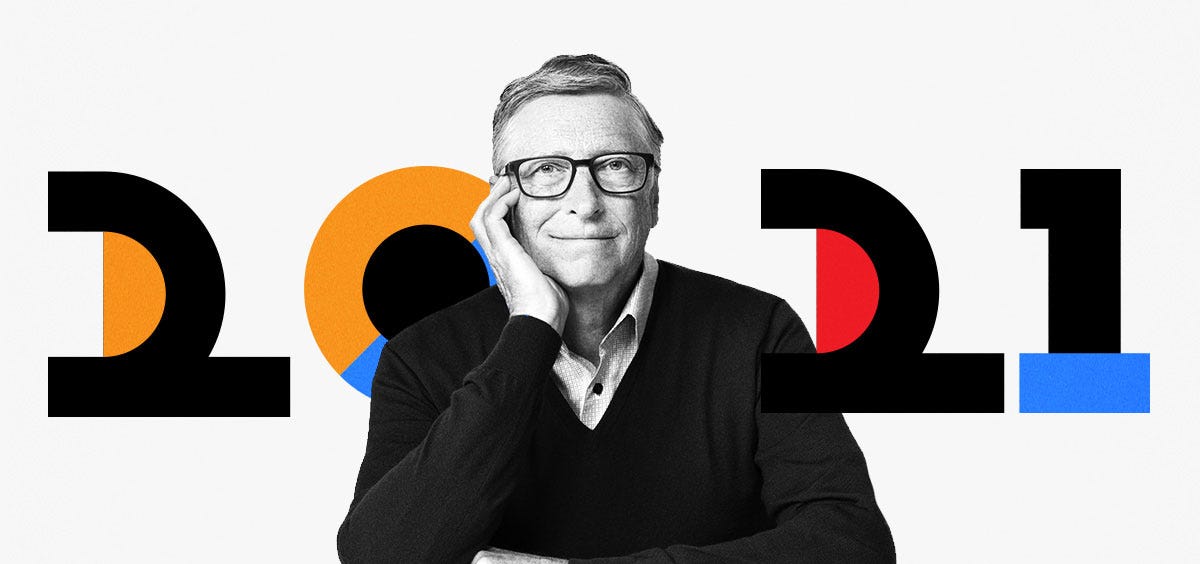2022: FEAR THE KNOWN UNKNOWN
The covid-19 pandemic has brutally exposed the world to the power of unknown risks, adding to the many learnings from the pandemic EPISODE # 54
Dear Reader,
A very Happy Monday to you. And a safe, wonderful and rewarding 2022.
Last year at exactly the same point of time I had penned a piece about the ‘Known Unknown’ while looking ahead at 2021. Sad to say that the covid-19 pandemic ebbed briefly but is yet to fade away. The latest mutation, Omicron, is spreading with even greater ferocity than Delta. Mercifully, so far, it has not been as lethal. Fingers crossed.
Tragically the theme from last year is very much alive. So my forecast piece for 2022 will revisit the ‘Known Unknown’ risks in the backdrop of the covid-19 pandemic, which had dodgy origins in Wuhan, China and continues to intimidate the world.
The cover picture this week is the same poignant one from last year. Thank you Rahul Sharma for this fabulous picture. My silent prayer to all those near and dear ones we lost in the last one year and salute to our frontline workers.
If you are not already a subscriber, please do sign up and spread the word.

UNKNOWN UNKNOWNS
If there is one thing the covid-19 pandemic has taught us in the last one year it is that the human race is extremely vulnerable and that uncertainty is a way of life. And this learning has come about in an unprecedented manner.
A devastation of this scale caused by a pandemic was last witnessed a century ago. And 18 months earlier no one, besides a section of the scientific community, had a clue about the Severe Acute Respiratory Syndrome corona virus-2 (SARS-CoV-2)—the virus powering the covid-19 pandemic.
In short we have been brutally exposed to the power of an unknown risk. Especially relevant in such a globalised and inter-connected world. While at an individual level this risk can be a handful and leave one blindsided, when this extends to the entire population, we are really talking about something else here.
I owe this understanding of risk to the former US Secretary of Defence Donald Rumsfeld. It was 19 years ago when I first heard the feisty Secretary use this complex term to define the terror risks facing the United States. He was speaking in the aftermath of the audacious terror attacks of 9/11.
“There are known knowns. There are things we know we know. We also know there are known unknowns. That is to say, we know there are some things we do not know. But there are also unknown unknowns, the ones we don't know we don't know.”
Our first thoughts on hearing the Secretary are what the hell! But actually listen to it carefully (and ignore the messenger) and you will figure that this is a profound method to assess risks.
I believe it is part of the accepted risk management lexicon. It is an adaptation of a model developed by psychologists for people to understand their relationships with themselves and others. It is called the Johari Window (sharing a wikipedia link here). Since then it has been adapted for other uses, including by Rumsfeld to capture the risks emanating from terrorism.
The Risk Matrix
To unpack the Rumsfeld quote one should think of it as a matrix.
After all there are only two options: Known and Unknown. And the variants are the combinations of these two.
I have borrowed from an online representation to unpack this in simple terms. We have four quadrants which capture the risks
The four quadrants are self explanatory. The least risk is in quadrant two and correspondingly the worst is in quadrant four.
Adapting this matrix to our current circumstance it is clear that in the last 18 months, thanks to the successful deployment of the vaccine, the risks emerging from the SARS-COV-2 virus have moved from the fourth quadrant—Unknown Unknowns, when the entire world was blindsided—to the third quadrant (Unknown Knowns), where the situation is gradually getting manageable.
Indeed this is a welcome positive. But just as first with the Delta and now with the Omicron variant, the threats from a rapidly mutating virus exist. While we know so much more about the virus today, there are so many things we still do not know (Unknown Knowns). As a result almost every claim about the pandemic is a conjecture at this stage. This is largely because of the fact that there is no data on the virus (and the corresponding risk) and hence it is impossible to list the consequences.
The bad news is that the covid-19 pandemic is not the last of the (Unknown Unknowns) risks out there. The disruption of global supply chains in the aftermath of the pandemic has stoked inflationary trends world over, giving rise to fresh macroeconomic risks to global growth. How this plays out for economies already battered by the pandemic is not easy to forecast because many economies have undergone structural change.
Similarly the first two decades of this Millennium was absorbed in tackling the threat of terrorism. The 9/11 attack was, as Rumsfeld described, an Unknown Unknowns risk. Tragically terror factories like Pakistan continue with their merry ways, implying that the terror threat is very much still around. And terror does not respect geography—as the United States learnt the hard way. Sad to say that no lessons seem to have been learnt.
The Antidote
The good news about the covid-19 pandemic is that the world’s scientists showed remarkable resilience in coming up with a vaccine in record time. The bad news is that the developed world preempted bulk of the vaccines leaving the developing world to fend for themselves. What we see playing out in Africa is the wages of these sins.
Mercifully India invested in developing domestic vaccine capability. Not only did it evade vaccine dependency on the West, but it also delivered a ‘Yes we Can’ moment. It did so by domestically producing the Covishield vaccine developed by Oxford-AstraZeneca and at the same time also approved the indigenously developed mRNA (messenger RNA)-based Covaxin.
The mRNA (messenger RNA) vaccine designed by Pfizer is a breakthrough according to Bill Gates. The mRNA vaccine teaches the cells in a human body to trigger an immune response against the virus.
In his annual letter posted on this blog Gates says:
“I think mRNA vaccines will ultimately be seen as the most consequential breakthrough of the pandemic. Proving that mRNA works as a vaccine platform has been a massive game changer—not just for this pandemic, but for the next one too. Now that mRNA is well-established, we’ll be able to develop safe and effective vaccines super-fast in the future.”
Not just this India delivered this vaccine to its people on an indigenously developed tech stack. But for this technology stack India would not have been able to walk the promise of ‘One Nation, One Jab’. It enabled an eligible individual to take either of the two doses of vaccines anywhere in the country.
Amazingly India is poised to reach the 900 million target for the first dose—this is like almost thrice the population of the United States—in less than a year since the jab project was rolled out.
Going back to our risk matrix it is apparent that the vaccine success with the initial variant of SARS-COV-2 virus has moved the incidence of risk from the fourth to the third quadrant. It could have reduced the risk further, but for the fact that little is known about the pace of mutations and the effectiveness of the existing batch of vaccines against them.
In the final analysis it is clear that the covid-19 pandemic, among other things, has redefined the risk matrix facing the world. Without a coordinated response, even to a limited degree, it is apparent that the populace would not have stood a chance—the number of fatalities is a grim reminder of the failure to contain such risks.
It may well be, as Gates points out, the beginning of the end of the covid-19 pandemic.
“I am hopeful, though, that the end is finally in sight. It might be foolish to make another prediction, but I think the acute phase of the pandemic will come to a close some time in 2022.”
Even if indeed this is true—I really wish so—the world and India in particular need to institutionalise the lessons of surviving a once in a century pandemic. It would help in improving our standings in the risk matrix.
Recommended Reading
The Bill Gates blog I referred to earlier is a must read.
It sums up the challenge and the hope. Further it is candid—even dwells on the personal upheavals in his life—and to the point.
Sharing some takeaways:
“The area I see as the biggest disappointment is the inequity of vaccine allocation.”
“This era has shown us how declining trust in public institutions is creating tangible problems and complicating our efforts to respond to challenges. Based on what I’ve seen over the last couple of years, I’m more worried than I’ve ever been about the ability of governments to get big things done.”
“I’ve never been a big New Year’s resolution person. I don’t have any specific goal in mind for 2022 (although I guess I still have a couple more weeks to think of one). But what I do hope is that next year is a lot more settled than this one.
Human beings are naturally resistant to change. Whether it’s the massive global upheaval of the last two years or transitions closer to home, it’s never easy to adjust to new ways of living.”
If you wish to read (highly recommended) the entire blog please click here.
Till we meet again next week. Stay safe






dear Anil,
Excellant article with all facts , figures and analysis. the first wave was progressive, second wave was aggressive lets hope this third wave is regressive and the world comes out of it with minimum loss of life. People need to come forward and participate actively in govts vaccination drive. Every day we are encouraging our students to register themselves for the vaccination.Keeping fingers crossed for good days ahead........
Although it ended on a hopeful note; I liked the line "every claim about the pandemic is conjecture at this stage......and final consequences cannot be predicted". I have been hearing scientists, doctors, viriologists, WHO officials and many other people on TV channels, posing as pundits in the matter, I don't remember anyone mentioning OMICRON, or the possibility of further mutations in future; but now a new line of group discussions have opened up. So I would just continue to be careful and hope that we are protected by the booster dose. Thanks for letting us know that we were very successful as a nation in not only producing and also making our own vaccine but also we have a creditable performance in vaccinating our huge population. Informative and topical.